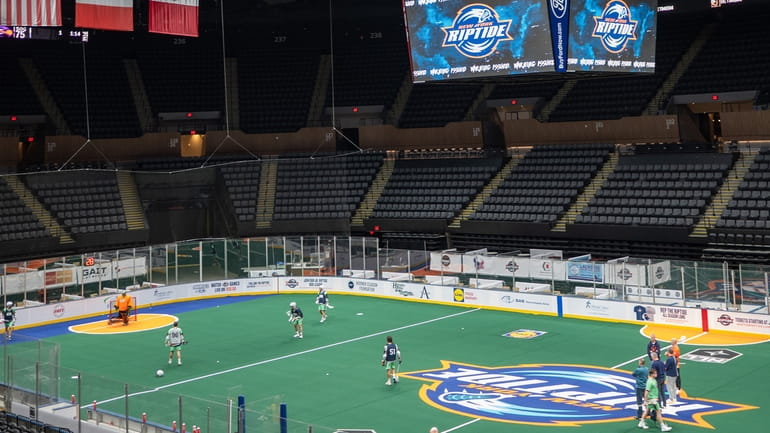Low tide at the Nassau Coliseum

New York Riptide players and staff at Nassau Coliseum. Credit: Howard Simmons
Daily Point
A winning goal for Riptide and Sands?
One month after the New York Riptide lacrosse team inked a two-year partnership deal with Las Vegas Sands sources say is valued at less than $1 million a year, the Riptide announced they’re leaving Long Island. For Canada.
There’s no question the Riptide’s decision is in part related to Sands’ ongoing effort to win one of three available downstate casino licenses.
The Riptide will move to Ottawa and be renamed the Ottawa Black Bears for the start of the 2024-25 season, in a move approved by the National Lacrosse League this week. They’ll be playing at the Canadian Tire Centre, an arena that holds more than 18,000 fans and is also home to the Ottawa Senators, a National Hockey League team.
The move comes in the wake of an uncertain future for the Riptide at its current home, Nassau Coliseum, where the team averages fewer than 5,000 fans a game. Sands is proposing a casino resort for the land around the Coliseum that would include a small entertainment venue — but the Riptide had sought an arena that could fit at least 10,000 — and nearby UBS Arena was too expensive.
After a lengthy negotiation over use of the Coliseum while the casino license process sorts out, the Riptide came to a two-year agreement with Sands that would have given the team hundreds of thousands of dollars a year and the Riptide would include Sands branding on its turf, jerseys and helmets. It’s unclear what will happen to that deal now. A spokeswoman for the Riptide said the team remains supportive of the Sands and its efforts at the Nassau Hub, even as the team heads north.
The move to Ottawa “was a wonderful business opportunity and considering the natural synergy with hockey and indoor lacrosse, it just made sense,” said Erin King Sweeney, a former Hempstead Town board member who now represents the Riptide.
Meanwhile, the casino licensing process remains in flux, as potential bidders await the answers to the second round of questions posed to the state’s Gaming Facility Location Board. The timetable for those answers remains unknown and at this point, it’s unclear whether the licenses will be awarded by the end of this year.
That’s not stopping some of Sands’ competitors from emerging with details about their bids. Related Companies’ proposal, unveiled Wednesday, would feature three skyscrapers, one for more than 1,500 units of housing, another for office space, and a third for the casino and hotel, all developed on a platform above the Hudson rail yards.
By making its move, is the Riptide making a bet that Sands is going to win one of the three available downstate casino licenses, and trying to get out before its home becomes a casino?
Or did it simply want to go where it was wanted — or where it got an even better deal?
— Randi F. Marshall randi.marshall@newsday.com
Pencil Point
Putin's new shoes
Credit: <A HREF="HTTPS://PATREON.COM/JEFFREYKOTERBA">PATREON.COM/JEFFREYKOTERBA</A>/Jeff Koterba
For more cartoons, visit www.newsday.com/nationalcartoons
Reference Point
LIRR woes

Stop us if you’ve heard this one: The Long Island Rail Road was in trouble.
You could spin a roulette wheel filled with dates over the decades and most likely land on one when that was true. In this case, it was February 1961 and Newsday’s editorial board was writing about Gov. Nelson Rockefeller getting involved in the railroad’s financial difficulties.
“Gov. Rockefeller’s rescue plan for the Long Island Rail Road, which this year anticipates a multimillion-dollar deficit, is shortly to be unveiled at Albany and is just about certain to receive the approval of the Legislature,” the board wrote in an editorial called “A Plan for the LIRR.”
Rocky was pitching a $4 million annual subsidy that would include Nassau and Suffolk counties and New York City forgiving some local real estate taxes, local communities taking over the maintenance and operation of stations and protection at grade crossings, and the state picking up the full cost of future projects to eliminate grade crossings.
The board wrote that “full marks” should be given to the governor and state lawmakers for recognizing “that the Long Island, like other commuter [rail]roads serving New York, cannot be permitted to sink out of sight.”
Normally, the use of the word “rescue” implies some permanence. When you rescue something, you presume it will not need rescuing again, at least not anytime soon. But Newsday’s board was under no illusions about the LIRR’s need to be saved.
For years, the LIRR had been a money-loser for its owner, The Pennsylvania Railroad, which at times starved the LIRR of funding. In 1949, the LIRR declared bankruptcy and in 1954, the state began supplying millions to improve the beleaguered railroad.
Tapping into the inglorious history, Newsday’s board wrote that Rockefeller’s plan “is at best a temporary measure. The permanent answer is the creation and financing of a tri-state commuter railroad authority that will keep mass transportation running efficiently, even at a loss. That is bound to come.”
The board was right on some counts. Rocky’s bailout was temporary. And the permanent answer was a public authority. In 1965, the state bought the LIRR from the Pennsylvania Railroad and formed what eventually became the Metropolitan Transportation Authority to run it.
The moves, however, did not mean an end to the financial difficulties. If anything, it transferred them from the LIRR to the MTA, which has needed numerous bailouts of its own. To paraphrase Newsday’s board, perhaps that, too, was bound to come.
— Michael Dobie michael.dobie@newsday.com, Amanda Fiscina-Wells amanda.fiscina-wells@newsday.com
Subscribe to The Point here and browse past editions of The Point here.
